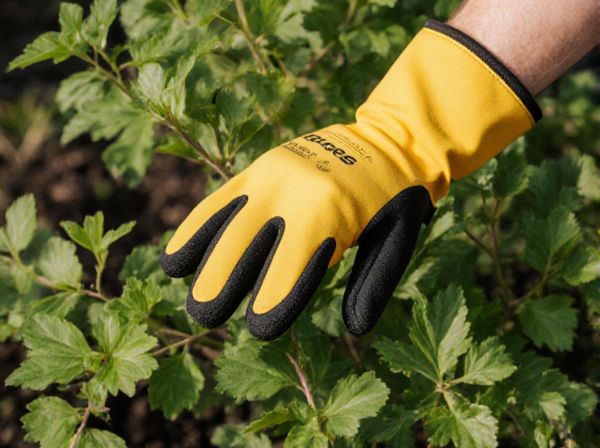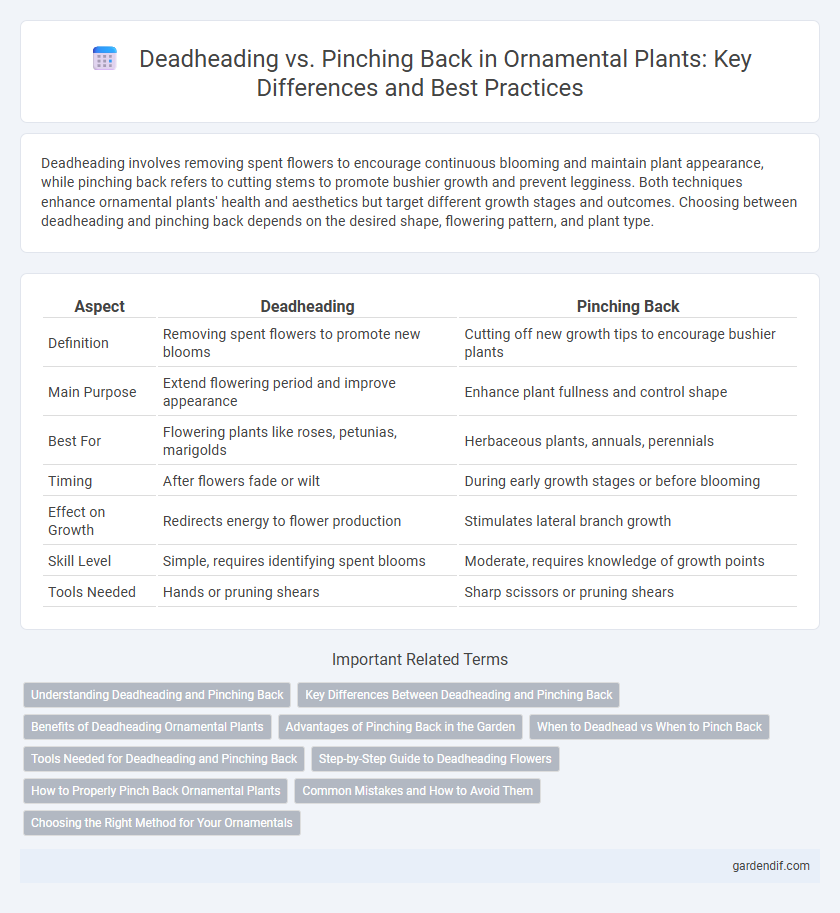
Deadheading vs Pinching back Illustration
Deadheading involves removing spent flowers to encourage continuous blooming and maintain plant appearance, while pinching back refers to cutting stems to promote bushier growth and prevent legginess. Both techniques enhance ornamental plants' health and aesthetics but target different growth stages and outcomes. Choosing between deadheading and pinching back depends on the desired shape, flowering pattern, and plant type.
Table of Comparison
| Aspect | Deadheading | Pinching Back |
|---|---|---|
| Definition | Removing spent flowers to promote new blooms | Cutting off new growth tips to encourage bushier plants |
| Main Purpose | Extend flowering period and improve appearance | Enhance plant fullness and control shape |
| Best For | Flowering plants like roses, petunias, marigolds | Herbaceous plants, annuals, perennials |
| Timing | After flowers fade or wilt | During early growth stages or before blooming |
| Effect on Growth | Redirects energy to flower production | Stimulates lateral branch growth |
| Skill Level | Simple, requires identifying spent blooms | Moderate, requires knowledge of growth points |
| Tools Needed | Hands or pruning shears | Sharp scissors or pruning shears |
Understanding Deadheading and Pinching Back
Deadheading involves removing spent flowers to encourage continuous blooming and prevent seed formation in ornamental plants. Pinching back entails trimming the growing tips of stems to promote bushier growth and increased branching. Understanding these techniques optimizes plant health and enhances floral display in gardens and landscapes.
Key Differences Between Deadheading and Pinching Back
Deadheading removes spent flowers to promote new blooms and extend the flowering period, primarily benefiting flowering plants like roses and chrysanthemums. Pinching back involves cutting or pinching stem tips to encourage bushier growth and prevent legginess, commonly used for annuals and herbaceous perennials. Both techniques enhance plant health, but deadheading targets bloom production while pinching back focuses on shaping and growth control.
Benefits of Deadheading Ornamental Plants
Deadheading ornamental plants promotes prolonged blooming by removing spent flowers, which redirects energy toward new growth and flower production. This practice enhances plant appearance and health by preventing seed formation and reducing the risk of disease. Regular deadheading increases the overall vibrancy and lifespan of ornamental plants in gardens and landscapes.
Advantages of Pinching Back in the Garden
Pinching back promotes bushier growth by encouraging multiple stems, which enhances the ornamental appeal of garden plants. This technique also improves air circulation within the foliage, reducing the risk of disease and promoting overall plant health. By stimulating new growth, pinching back extends the flowering period and increases the density of blooms, making gardens more vibrant and visually appealing.
When to Deadhead vs When to Pinch Back
Deadheading is ideal for flowering plants like roses and petunias once blooms fade to encourage more blossoms and prevent seed formation. Pinching back is best during early growth stages of ornamental shrubs and perennials such as coleus and chrysanthemums to promote bushier, denser foliage. Timing deadheading aligns with post-flower bloom while pinching back should occur before plants reach maturity for optimal shape and vigor.
Tools Needed for Deadheading and Pinching Back
Deadheading ornamental plants requires tools such as pruning shears or scissors to remove spent flowers cleanly and prevent disease, while pinching back involves using fingers or small garden snips to trim new growth and encourage bushier plants. Clean, sharp tools are essential for both techniques to minimize plant damage and promote healthy regrowth. Garden gloves and sanitation sprays also help maintain hygiene during deadheading and pinching back.
Step-by-Step Guide to Deadheading Flowers
Deadheading flowers involves removing spent blooms to encourage continuous flowering and improve plant appearance. Start by identifying faded or wilted flowers, then use clean, sharp scissors or pruning shears to cut just above the first set of healthy leaves or buds. Regular deadheading promotes plant health, reduces disease risk, and extends the blooming period in ornamental gardens.
How to Properly Pinch Back Ornamental Plants
Properly pinching back ornamental plants involves using clean fingers or pruning shears to remove the tips of new growth, encouraging bushier and more compact foliage development. This method differs from deadheading, which removes spent flowers to promote blooming rather than enhancing plant shape. Pinching back at the right time--usually early in the growing season--stimulates lateral branching and improves the overall aesthetic of plants such as geraniums, coleus, and petunias.
Common Mistakes and How to Avoid Them
Deadheading and pinching back are essential techniques in ornamental gardening to promote healthier growth and prolonged bloom periods. A common mistake is over-pruning during pinching back, which can stunt plant development, while neglecting deadheading leads to wasted energy on seed production instead of new flowers. To avoid these errors, gardeners should trim only the tips of stems for pinching back and remove spent blooms regularly to encourage continuous flowering.
Choosing the Right Method for Your Ornamentals
Deadheading involves removing spent flowers to promote continuous blooming and improve plant appearance, while pinching back entails trimming stems to encourage bushier, more compact growth. Choose deadheading for ornamentals like roses and petunias that benefit from flower removal to extend blooming periods, and opt for pinching back with plants such as coleus and chrysanthemums to enhance their form and density. Understanding the growth habits and bloom cycle of your specific ornamental species is essential for selecting the most effective maintenance technique.
Deadheading vs Pinching back Infographic

 gardendif.com
gardendif.com